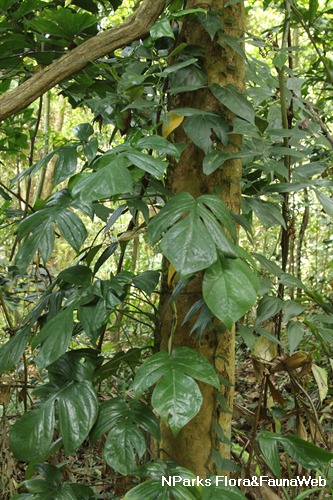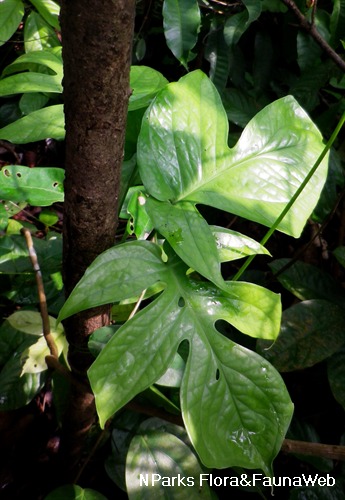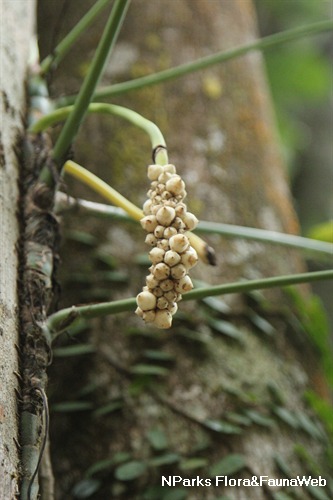
Back
Amydrium medium (Zoll. & Moritzi) Nicolson
| Family Name: | Araceae |
| Synonyms: | Anadendrum medium (Zoll. & Moritzi) Schott, Epipremnopsis huegelii (Schott) Engl., Epipremnopsis media (Zoll. & Moritzi) Engl., Epipremnopsis subcordata M. Hotta, Epipremnum medium (Zoll. & Moritzi) Engl., Epipremnum truncatum Engl. & K. Krause, Rhaphidophora huegelii Schott, Rhaphidophora korthalsiana Engl., Scindapsus huegelii (Schott) Ender, Scindapsus medius Zoll. & Moritzi |
| Common Name: | Sakat Gajah |
Name
Classifications and Characteristics
| Plant Division | Angiosperms (Flowering Seed Plants) (Monocotyledon) |
|---|---|
| Plant Growth Form | Climber |
| Lifespan (in Singapore) | Perennial |
| Mode of Nutrition | Autotrophic |
| Plant Shape | Irregular |
Biogeography
| Native Distribution | Southwest Thailand, Peninsular Malaysia, Singapore, Sumatra, Java, Borneo, the Philippines, and the Moluccas |
|---|---|
| Native Habitat | Terrestrial (Primary Rainforest, Secondary Rainforest) |
| Preferred Climate Zone | Tropical |
| Local Conservation Status | Native to Singapore (Endangered (EN)) |
Description and Ethnobotany
| Growth Form | Slender bole climber exhibiting leaf dimorphism - leaves of seedlings or juvenile plants differ from those of the adult plants; adult foliage often developing only when the vine has found support on a tree trunk. |
|---|---|
| Foliage | Juvenile foliage: Leaves greyish green to green, ovate, leaf blade entire or dissected, often with perforations; both types of leaves often present on the same vine. Adult foliage: Leaves green to dark green, deeply pinnatifid; leaf blade with perforations along rachis. |
| Flowers | Its singly borne, erect spadix is 3–6 by 1.5 cm, enclosed within an about 5 cm-long, white spathe that reflexes and sheds. |
| Fruit | The infructescence is brown when ripe. |
| Habitat | It grows in primary lowland rainforests. It occurs locally in forests at Bukit Timah Nature Reserve, Rifle Range Road, and Singapore Botanic Gardens Rain Forest. |
| Associated Fauna | Its flowers are insect-pollinated and its fruits are probably bird- or mammal-dispersed. |
| Cultivation | It can be propagated by seeds and stem cuttings. |
| Etymology | Greek amydron, dark, dusky, indistinct, uncertain, probably referring to the indistinct features of the type species from other species of this genus; Latin medium, intermediate, middle, possibly referring to the simple to pinnatisect leaves |
Landscaping Features
| Landscaping | It is suitable for parks, in shaded areas growing on tree trunks. |
|---|---|
| Desirable Plant Features | Ornamental Foliage, Ornamental Fruits |
| Landscape Uses | Parks & Gardens, Small Gardens, Interiorscape/ Indoor Plant |
Fauna, Pollination and Dispersal
| Pollination Method(s) | Biotic (Fauna) |
|---|---|
| Seed or Spore Dispersal | Biotic (Fauna) |
Plant Care and Propagation
| Light Preference | Semi-Shade, Full Shade |
|---|---|
| Water Preference | Moderate Water, Occasional Misting |
| Rootzone Tolerance | Moist Soils, Well-Drained Soils, Fertile Loamy Soils, Easy to Grow |
| Pest(s) | Chewing Insects, Sucking Insects |
| Propagation Method | Stem Cutting |
Foliar
| Foliage Retention | Evergreen |
|---|---|
| Mature Foliage Colour(s) | Green, Green - Light Green, Silver / Grey |
| Mature Foliage Texture(s) | Leathery |
| Foliar Type | Simple / Unifoliate |
| Foliar Arrangement Along Stem | Alternate |
| Foliar Attachment to Stem | Petiolate |
| Foliar Shape(s) | Non-Palm Foliage |
| Foliar Margin | Entire, Pinnately Lobed / Pinnatifid |
Floral (Angiosperm)
| Flower & Plant Sexuality | Unisexual Flowers , Monoecious |
| Flower Colour(s) | White, Cream / Off-White |
|---|
| Flower Texture(s) | Smooth |
| Flower Grouping | Cluster / Inflorescence |
| Flower Location | Axillary |
| Inflorescence Type | Spathe & Spadix |
Fruit, Seed and Spore
| Mature Fruit Colour(s) | Brown |
|---|---|
| Fruit Classification | Simple Fruit |
| Fruit Type | Fleshy Fruit , Non-Accessory Fruit |
Image Repository
Others
| Master ID | 31074 |
|---|---|
| Species ID | 5463 |
| Flora Disclaimer | The information in this website has been compiled from reliable sources, such as reference works on medicinal plants. It is not a substitute for medical advice or treatment and NParks does not purport to provide any medical advice. Readers should always consult his/her physician before using or consuming a plant for medicinal purposes. |


